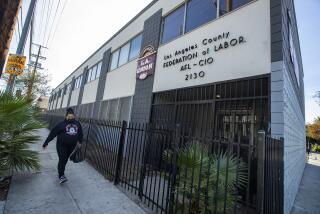City Hall Gang of 5 Keeps Conspiracy Rumors Alive
- Share via
The talk at San Diego City Hall is about secrecy, and the deft way a Gang of Five on the City Council snatched poverty funds away from the district of Councilman Bob Filner.
Filner, the ex-history professor, complains that Henderson, McCarty, McColl, Roberts and Struiksma cooked up a conspiracy in private before voting, without comment, to shift $1.7 million to their own districts. A neighborhood group wants federal intervention.
It stretches credulity that someone schooled in faculty politics could be caught off-guard by treachery and backstage plotting. But that’s a side issue; the main concern now is secrecy and its fallout.
Council members come and go (sometimes not quickly enough), but a penchant for the private deal and the clandestine huddle remains. Out-maneuvered members cry foul, the newspapers bawl their indignation, and nothing changes.
A newspaper sues to stop the council under Pete Wilson from raising the city manager’s salary in closed session. The newspaper wins, and Wilson devises a system of head nods and hand signals--government by pantomime.
A council majority slices up the city budget in private. A newspaper sues, the council gets scolded by the city attorney, and, two years later, some of the same participants are part of the job done on Filner and the people of San Ysidro.
The five who voted against Filner can argue that his district isn’t the only one that can use some federal grant money. That’s what it’s like with secrecy. If you like what it produces, it’s called coalition-building and serving the people. If not, it’s a cabal and an outrage.
Secrecy, of course, has a twin: suspicion, the feeling that someone is getting more than you are. If suspicion were energy, City Hall would have no need of SDG&E.;
At Large remembers one afternoon in 1981 when reporters were peering down on the council chamber from the press gallery and noticed three council members engaged in animated conversation in a corner.
A fourth council member, at odds with the three others, telephoned the reporters and suggested they investigate.
Reporters scurried down a flight of stairs, hustled down a hallway, then crept silently to a door behind the dais, whence they could hear the private discussion before being spotted. Journalistic hearts pounding.
And what were the three discussing with such intensity? A plan to hire or fire a certain bureaucrat? A plot to divide the street-sweeping budget three ways? A way to raise their own salaries and not get caught?
No. They were discussing the bargains available to shoppers at that San Diego cult, the Price Club.
Conclusion: When you start assuming your colleagues are schemers, a lot of time is consumed in political paranoia. Or: One man’s secret conspiracy is often another man’s marked-down toaster oven.
Novel Isn’t the Word for It
From a Daily Aztec story about Jerry Bumpus, professor of English at San Diego State University:
“Bumpus said the reason that his one novel, ‘Anaconda,’ and three short story collections have not retained the interest of large publishing houses is his choice of unusual topics, such as a boy who is fascinated with necrophilia and a dog that can write.”
Proof that the publishing business is run by know-nothings.
The Art of Needling a Dog
The Canine Blood Bank, operated by the Emergency Animal Clinic of San Diego, has issued a call for donors.
The donor dog gets a free physical, blood typing and analysis, and free transfusions for a year. Its owner gets a T-shirt.
Surprisingly, most dogs--like veteran donor Bright Eyes, a 3-year-old Doberman pinscher--are less afraid of the needle than many human blood bank donors.
“If they’re going to bite you, they’ll bite you when you first poke them,” said Kay Edwards, an animal health technician at the clinic in Mission Valley. “After that, it’s easy.”
More to Read
Sign up for Essential California
The most important California stories and recommendations in your inbox every morning.
You may occasionally receive promotional content from the Los Angeles Times.













